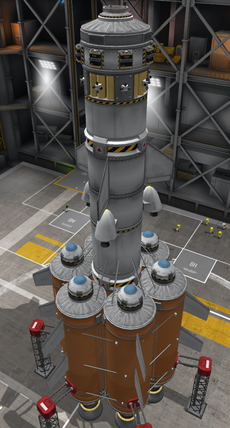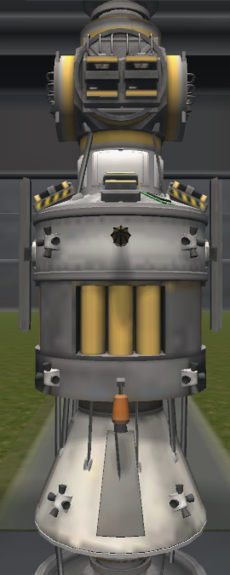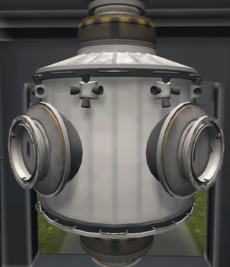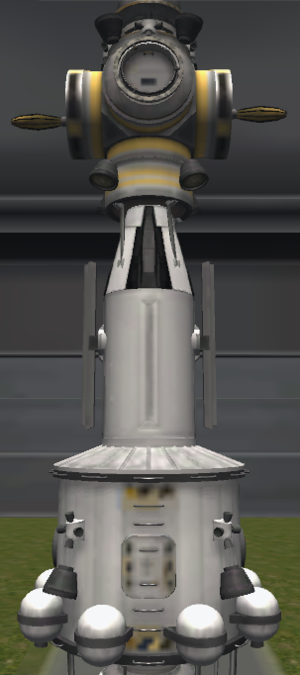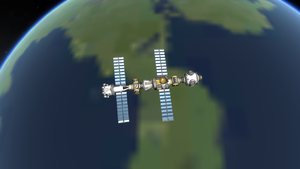Tutorial: ISS
| “ | "It's fantastic. I can't say how much this means to all of us." — Robert Cabana, first person to enter the ISS |
” |
Welcome to my first tutorial! Here, we will try to re-enact one of the most important space programs: the International Space Station(ISS/MKC)
All of the designs are based on actual modules and rockets. Of course, I can't do it perfectly, but I am trying my best. Also, I am doing it without any mod parts, but I use MechJeb for autopilot. I will go and add more launches when I'll do them myself.
Contents
Vocabulary list
Just so you know, some terms I am using here :
- Zenith - top side of the ship; usually oriented away from the orbited body.
- Nadir - bottom side of the ship; usually oriented towards the orbited body.
- Port - left side of the ship
- Starboard - right side of the ship
- Front - front side/end of the ship
- Aft - back side/end of the ship
- LPA - launch phase angle; angle between the vector of the launching rocket and the line drawn from the launchpad to another object in sky
Proton-K - Russian Launcher
This is a recreation of the Russian rocket Proton 8K82K. I used it for all of the current modules, even if American modules were launched with the Space Shuttle.
Ship Design
- Payload
- Add whatever you want; the current maximum launched is 13.02 tons (Zarya)
- Third Stage
- 1x Clamp-o-tron Docking Port OR a decoupler/separator for the payload
- 1x MechJeb 1m Pod OR any pod you will use
- 1x Rockomax X200-8 Fuel Tank
- 8x Z-400 Rechargeable Battery (if you use an unmanned pod)
- 1x FL-R1 RCS Fuel Tank
- 8x RV-105 RCS Thruster Block
- 1x Rockomax "Poodle" Liquid Engine
- Second Stage
- First Stage
- 1x Rockomax Brand Adapter
- 7x Rockomax Jumbo 64 Fuel Tank (1 in middle + 6 symmetric radial NO DECOUPLERS)
- 7x Rockomax "Mainsail" Liquid Engine
- 6x S.A.S. Module (only on the exterior 6 tanks)
- 6x Mk16-XL Parachute
- 12x AV-R8 Winglet (not in actual rocket but is necessary for stability)
- 12x EAS-4 Strut Connector (connect to next stage for stability and between the tanks)
Zarya - 1A/R
Zarya (Dawn in Russian) or FGB (Functional Cargo Block) was the first module of the ISS. FGB Zarya initially provided flight control as well as electricity and fuel supplies. Now, it is mostly used for storage. It is the connection between the Russian and American side of the station.
Ship Design
| Statistics | |
|---|---|
| Mass (full) | 13.02 t |
| Δv (vacuum) | 1 081 m/s |
Front to aft (1st-level bullets indicate the body; 2nd-level indicates radially-mounted parts):
- 1x Clamp-o-tron Docking Port
- 1x Rockomax Hubmax Multi-Point Connector
- 1x Clamp-o-tron Docking Port (nadir on Hubmax)
- 3x M-1x1 Structural Panel (zenith, port and starboard on Hubmax)
- 2x RV-105 RCS Thruster Block (port and starboard on the 1x1 panels)
- 2x Z-400 Rechargeable Battery (zenith on 1x1 panels)
- 1x MechJeb 1m Pod OR S.A.S. Module (if you don't have MechJeb, put a manned pod on the launcher)
- 1x Rockomax Brand Adapter 02
- 1x Rockomax X200-8 Fuel Tank
- 2x Gigantor XL Solar Array (port and starboard)
- 4x RV-105 RCS Thruster Block (put diagonnaly so it doesn't touch the arrays)
- 1x Communotron 88-88 (zenith so it doesn't get in the way of docking)
- 1x Communotron 16 (nadir)
- 1x FL-R1 RCS Fuel Tank
- 1x Advanced S.A.S. Module, Large
- 4x RV-105 RCS Thruster Block
- 2x Rockomax 24-77 (zenith and nadir)
- 1x S.A.S. Module
- 1x Rockomax Brand Adapter
- 8x EAS-4 Strut Connector (connect to A.S.A.S.)
- 4x RV-105 RCS Thruster Block
- 1x Rockomax Brand Adapter 02
The Mission
The original Zarya launch happened on November 20, 1998. I can't find the original orbital information The module was placed on a Low Earth Orbit, which usually corresponds to 160 to 2000 km. The current ISS orbit is 402km PE * 424km AP with a 51.6 orbital inclination. So, if you want to make it good, launch as usual, with a gravity turn starting at 10km. Turn towards 38.4 degrees (the 51.6 inclination). Continue until you reach 424km apoapsis, then burn there to get 402km periapsis. I'll have to test myself if it's possible with the current Proton-K design It is possible to achieve this orbit with precise flying or an autopilot. It leaves 60% of 3rd-stage fuel and a full on-station tank.
When you have the stable orbit, open the solar panels and the antennas. Move the station to orient it the good way (the one radial docking port facing the Earth; the Hubmax towards your prograde vector). Transfer any fuel or electricity (if you are in the dark zone) then either undock the third stage or keep it until the Zvezda mission.
There you go, the ISS begins to exist!
Unity - 1A
| colspan="2" | ||
|---|---|---|
| Statistics | ||
| Mass (full) | 3.79 t | |
Unity, also known as Node 1, is the first American-only module on the ISS. It is basically a connector between many parts of the station. It was delivered with two PMA (Pressurized Mating Adapters), one that is permanently placed between Zarya and Unity, and the second has moved many times since its installation.
Ship Design
I can't really simulate the PMA's, because they aren't straight but a bit tilted. Here's what I did:
- 1x PPD-10 Hitchhiker Storage Container
- 8x RV-105 RCS Thruster Block
- 4x BZ-52 Radial Attachment Point
- 4x Clamp-o-tron Docking Port (on the BZ-52's;)
- 1x Rockomax Brand Adapter 02
Mission Phases
The original launch happened 2 weeks after deployment of Zarya, on December 4, 1998.
Launch
For my launch, I had to use the Proton-K launcher, because there isn't any solid fuel boosters as powerful as was used by the Space Shuttle. It had two boosters, each at 12.5 MN while the Rockomax booster has only 300 kN (2.4 %).
Try your best to put it on the same orbit as Zarya. If you have an auto-pilot, use the "Launch to rendezvous" function. If not, try to send it with Zarya at a 45 degree LPA. Once again, the orbit is 424 km AP × 402 km PE.
Rendez-vous
Check the tutorials on rendezvous and docking if you don't know how to. The goal is to attach one of the PMA ends (front or aft, they're symmetrical) to the Hubmax (front end). You may need to switch between vessels to put them in the right diretions.
They connected!
On the actual mission, there were 3 EVA's to connect cables between the modules, and once to enter the ISS. As of 0.19.4, you can only do that last point. If you brought any Kerbonauts, put them in EVA and let them enter the Hitchhiker. After some time, get them back on what's left of your launcher.
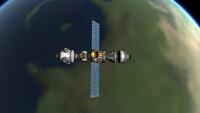
Landing on Kerbin
I didn't use a manned pod, so I just dropped the launcher with as less fuel left as possible. Instead, try to return the Kerbonauts on the last stage of your Unity launcher. You can pump the fuel from the Zarya launcher if it's still docked; you'll also need the aft docking port of Zarya for the next mission.
Zvezda - 1R Coming Soon
Working on it...
What now
Possibly a lunar base? Let your imagination run wild!

